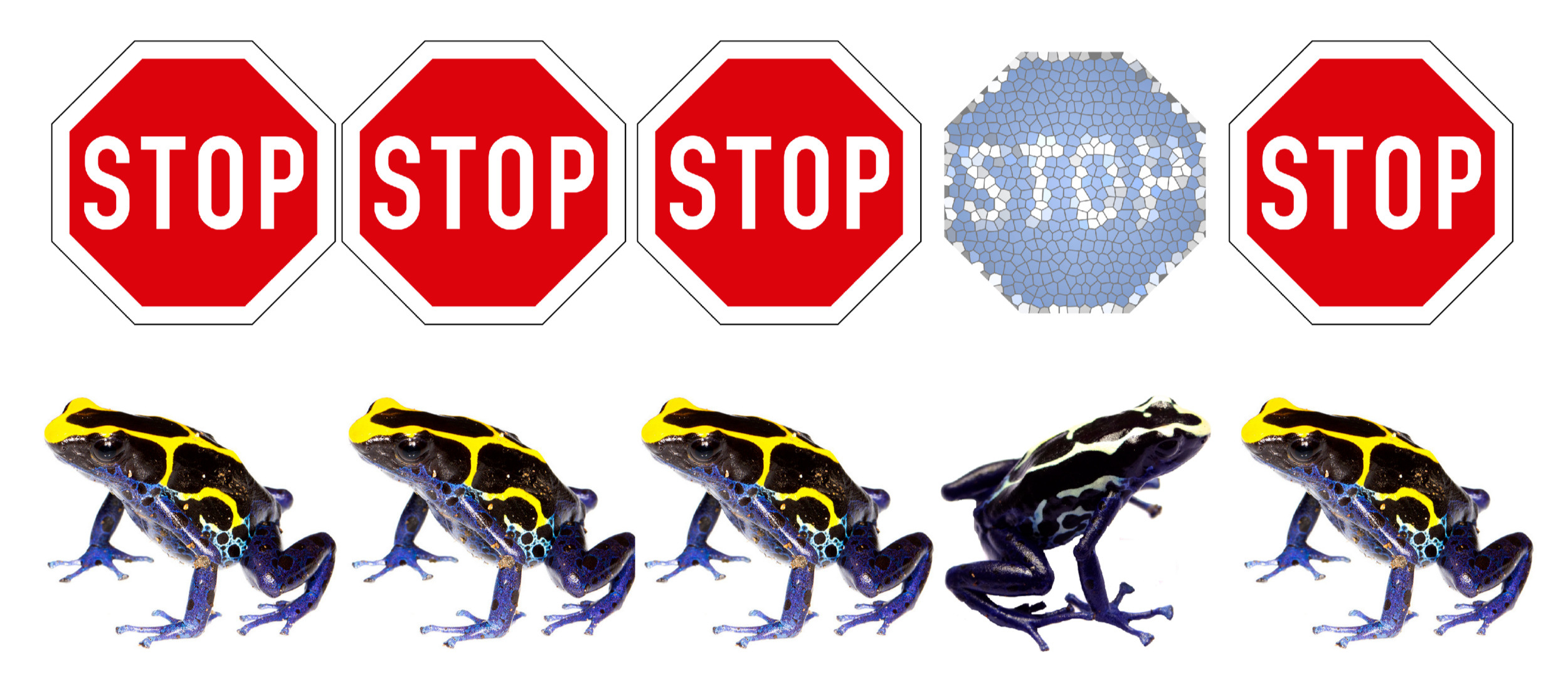Survival of the Weaker
Toxic frogs with weak defenses persist in the gene pool alongside stronger competitors. Diversity exists even when we expect otherwise.
Yellow type of the Dyeing Poison-Frog, Dendrobates tinctorius.
Image by J.P. Lawrence.
Diversity is a hallmark of life and it shows up in unexpected places. A multi-national team of evolutionary biologists investigated how two types of poison frog co-exist when we expect only one. Their innovative study uncovers conditions where diversity flourishes against the odds, and offers new perspectives on chemical defense. The project was a collaboration between the University of Mississippi (UM), the University of Jyväskylä (JYU), the CNRS, LEEISA and John Carroll University (JCU), with supervision from Brice Noonan (UM) and Johanna Mappes (JYU). J.P. Lawrence (UM) and Bibiana Rojas (JYU) lead the study and published the findings in the Proceedings of the National Academy of Sciences (PNAS) on September 2nd 2019.
Many creatures carry warning colors that signal toxicity, such as wasps with yellow bands. The Dyeing Poison Frog (Dendrobates tinctorius) of French Guiana also has yellow stripes to keep predators away, but some have white stripes instead. This is an anomaly of evolution because predators learn to avoid warning colors through bad experience, and rare warning colors are harder to learn. It’s like how everyone has already learned that red means stop, so red stop signals will be more effective than blue ones. The team headed by Doctors Lawrence (now at the University of California Irvine) and Rojas propose evolutionary explanations for how nature allows rare warnings to persist.
The blue stop sign is less effective than red ones, because red is a common signal for stop. The white-striped frog has a less effective signal than yellow-striped frogs, because yellow is a more common signal for toxicity. Scientists do not expect frogs with different warning colors, just as drivers do not expect stop signs with different colors.
Image Sources: Red Stop Sign by United Nations – Vienna Convention on Road Signs and Signals, Public Domain. Blue Stop Sign by Nice4What, CC BY-SA 4.0. Yellow frog by J.P. Lawrence. White frog by B. Rojas.
Firstly, rare or weak signals can persist under the protection of stronger signals. The researchers show that predators learn to avoid more distasteful yellow frogs and generalize this avoidance to white frogs. Although the stronger defenses of yellow frogs should allow them to out-compete the whites over time, genomic analysis revealed that the population of white frogs is genetically separate from the yellows. Thus, diversity can exist within a single population (due to generalized learning) and between different populations (due to genetic isolation). These results make a valuable contribution to the field, according to independent poison-frog expert Professor Kyle Summers of East Carolina University. Summers says ‘[The results] provide… important insights into [warning signals] and the methods used to study it’.
The initial experiments were modest in scope, but strange results inspired the researchers to develop new methods. “We went from experiment to experiment, and this research snowballed,” says Dr. Lawrence. Dr Rojas says “We faced the difficulty of not having an established method to quantify predator reaction to the chemical defenses... However, that difficulty turned into one of the biggest assets of our study, as we eventually succeeded at developing a method”.
The new method improves the ecological relevance and precision of measuring predator-prey interactions. Past studies have assumed that toxicity is everything, and measure it by injecting mice with defensive chemicals. But prey survival and evolution depends on whether they are eaten or spat out, not the blood chemistry of their predators. Thus, the researchers used skin extracts mixed with oats to get a separate measure of distastefulness. They show that toxicity and distastefulness are better considered independently.
Dr Rojas says “To me, the biggest surprise came from the fact that the frogs [with] higher amount of toxins in their skin are not necessarily the ones that birds find most distasteful. This finding challenges previous assumptions that most toxic equals most unpalatable.” Dr Lawrence says this confers with his own experience of frog-licking (for science), but adds that “it was very satisfying… that our anecdotal test of unpalatability was corroborated by more rigorous experiments.”
The research was funded by the Academy of Finland, the Agence Nationale de la Recherche, the American Society of Ichthyologists and Herpetologists, and the Society for the Study of Amphibians and Reptiles.
White type of the Dyeing Poison-Frog, Dendrobates tinctorius.
Image by B. Rojas.
“This paper focuses on how variation in aposematic signals can be maintained within and between populations, a topic of considerable current interest in evolutionary biology. The authors bring to bear a wide variety of methodological approaches in a well-designed series of experiments that allow them to address multiple aspects of this phenomenon. Their over-arching hypothesis is that signal generalization can allow substantial within-population variation (polymorphism) despite positive frequency dependent selection, and that retention of suboptimal genotypes and associated phenotypes in isolated populations can lead to the maintenance of between population variation (polytypism). Their results provide support for a number of key predictions from this hypothesis, in addition to other important insights into aposematism and the methods used to study it. Overall, a valuable contribution to the field.” - Professor Kyle Summers (East Carolina University)
The Research Article and Contacts:
Lawrence, Rojas, Fouquet, Mappes, Blanchette, Saporito, Bosque, Courtois and Noonan. Weak warning signals can persist in the absence of gene flow. PNAS, 2019 DOI: 10.1073/pnas.1901872116
Bibiana Rojas
Department of Biological and Environmental Sciences
University of Jyväskylä, Finland
bibiana.rojas@jyu.fi
@biobiiana
bibianarojas.co
J.P. Lawrence
Department of Ecology and Evolutionary Biology
University of California Irvine, USA
JPLarry@gmail.com
jp-lawrence.com



